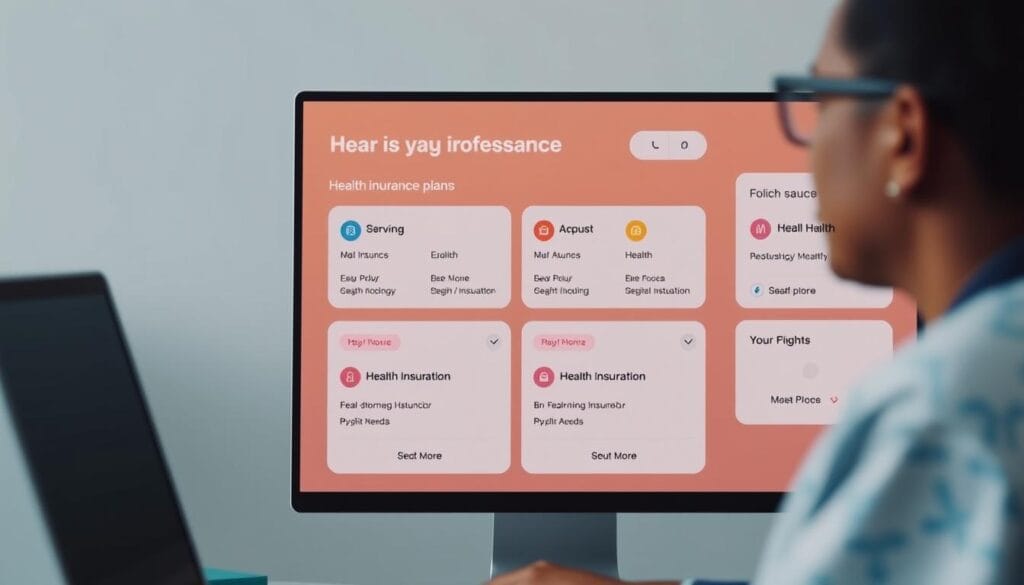The insurance industry is on the cusp of a revolution, with the global InsurTech market projected to reach $82.3 billion by 2029, growing at a CAGR of 52.7%. This significant growth is driven by the need for more efficient, personalized, and transparent insurance solutions.
The rapid adoption of cutting-edge technologies like AI, blockchain, and IoT is transforming the way insurance products are developed, distributed, and managed. As a result, insurtech platforms are simplifying complex insurance processes, improving customer experience, and enhancing overall industry efficiency.
This comprehensive guide explores the most innovative insurtech solutions that are reshaping the consumer insurance landscape in 2025.
Key Takeaways
- The insurtech market is expected to reach $82.3 billion globally by 2029.
- Technology is simplifying insurance processes and improving customer experiences.
- Cutting-edge technologies like AI and blockchain are driving innovation.
- Insurtech platforms are enhancing efficiency and transparency in the industry.
- Consumers can expect more personalized and efficient insurance solutions.
The Evolution of Insurtech: Transforming the Insurance Landscape

Insurtech has emerged as a pivotal force in reshaping the insurance landscape through technological innovation. The insurance industry, once characterized by traditional methods, has seen a significant transformation in recent years.
From Traditional Methods to Digital Innovation
The shift from paper-based, agent-dependent systems to digital-first platforms has been remarkable. Initially, in the 1990s-2010s, the focus was on making insurance more accessible through online platforms, allowing customers to compare quotes and purchase policies directly. This marked the beginning of digital innovation in the industry.
From the 2010s onwards, the integration of big data, analytics, and artificial intelligence (AI) has propelled insurtech forward, enabling personalized and more accurate risk assessments, faster underwriting, and advanced claims management via chatbots. This technological advancement has not only improved operational efficiency but also reduced costs and reserve requirements for insurers.
The Growth of the Insurtech Market Through 2025
The insurtech market is poised for continued growth through 2025, driven by the accelerating adoption of digital solutions across various insurance sectors. As technology continues to evolve, traditional insurers are responding to insurtech innovations by forming partnerships, making acquisitions, or developing their own digital capabilities to remain competitive.
The industry is witnessing a transformation not just in operational processes but also in business models, creating new possibilities for insurance product design and distribution. With the integration of advanced technologies and data analysis, the future of insurance looks increasingly personalized and efficient.
Why Consumers Need Innovative Insurance Solutions in 2025

The insurance industry is on the cusp of a revolution in 2025, with consumers increasingly expecting personalized and seamless digital experiences. As the insurtech space continues to evolve, it’s crucial to understand the driving forces behind this change.
“The future of insurance is not just about adopting new technologies, but about reimagining the entire customer experience,” says an industry expert. This reimagining is driven by consumers’ growing demands for more analytics on their data and a seamless digital experience, from obtaining quotes to filing claims.
Meeting Growing Customer Demands and Expectations
Consumers today expect more from their insurance providers. They demand personalized solutions that cater to their individual needs, rather than one-size-fits-all policies. Insurtech companies are rising to this challenge by offering tailored insurance products that meet the unique requirements of modern consumers. For more information on how insurtech is transforming the insurance landscape, visit https://aimoneymatters.com/solutions/.
Providing Seamless Digital Experiences
The modern consumer expects a seamless digital experience, akin to what they receive from other industries like retail and banking. This includes instant quotes, mobile-first interfaces, and 24/7 service availability. Insurtech platforms are leveraging technologies like AI and machine learning to provide these experiences, making insurance more accessible and user-friendly.
Addressing New Risks and Coverage Needs
Emerging risks such as gig economy work, cyber threats, climate change impacts, and digital asset protection require innovative insurance solutions. Insurtech companies are developing new products that address these risks, providing consumers with the coverage they need in a rapidly changing world. By embracing technology, insurers can improve operational efficiency, enhance customer experience, and reduce costs and time to market.
Key Technologies Driving Insurtech Innovation
Several key technologies are driving insurtech innovation, transforming the way insurance companies operate and interact with customers. These technologies are not only enhancing the efficiency of insurance processes but also improving customer experiences.
AI and Machine Learning Integration
Artificial intelligence (AI) and machine learning (ML) are revolutionizing the insurance industry by enhancing underwriting processes, detecting fraud, and improving customer service. For instance, AI-powered chatbots are being used to provide 24/7 customer support, enhancing user experience. Global spending on AI-centric systems was estimated at $154 billion in 2023, highlighting the significant investment in this technology.

Blockchain for Transparency and Security
Blockchain technology is being utilized to create transparent, immutable records that streamline claims processing and enhance data security. This technology enables smart contracts, which automate various processes, reducing the need for intermediaries. The global blockchain market was valued at approximately $7.4 billion in 2022 and is projected to exceed $94 billion by 2027.

IoT and Telematics for Personalized Coverage
Internet of Things (IoT) devices and telematics are enabling usage-based insurance models that more accurately reflect individual risk profiles. For example, driving behavior trackers for auto insurance and wearable health monitors for life and health coverage are becoming increasingly popular. The worldwide automotive IoT market is expected to reach a revenue of $251.9 billion in 2024.

Advanced Data Analytics for Risk Assessment
Advanced data analytics capabilities are allowing insurers to process vast amounts of structured and unstructured data to identify risk patterns. This enables more accurate risk assessments and personalized insurance policies. For more information on how AI is streamlining insurance claims, visit Streamline Insurance Claims with AI.
How Insurtech Platforms Are Simplifying Insurance
Insurtech platforms are revolutionizing the insurance industry by simplifying complex processes. These platforms aim to provide a holistic approach for customers, integrating various services and technologies into a seamless user experience. By doing so, they reduce complexity, enhance convenience, and make it easier for customers to buy, review, and change their policies as needed.
Streamlined Application and Enrollment Processes
Modern application and enrollment processes are being transformed through data pre-filling, natural language processing, and intelligent interfaces. These innovations can significantly reduce the time required for enrollment from days to mere minutes. By streamlining these processes, insurtech platforms are making it easier for customers to initiate their insurance coverage.
Automated Claims Processing and Management
Automated claims processing systems are leveraging AI, computer vision, and digital communication tools to assess damage, validate claims, and issue payments with minimal human intervention. This not only speeds up the claims process but also reduces the administrative burden on insurance providers. As a result, customers benefit from faster and more efficient claims management.
Personalized Policy Management and Customer Support
Personalized policy management tools are giving consumers unprecedented visibility and control over their coverage. Customers can adjust parameters, add endorsements, or make changes through self-service portals. Additionally, customer support is evolving through AI-powered chatbots, virtual assistants, and omnichannel communication strategies, providing immediate and consistent assistance across multiple touchpoints.
By implementing these simplification strategies, leading insurtech platforms are demonstrating measurable improvements in customer satisfaction, retention rates, and operational efficiency. As the insurance industry continues to evolve, the role of insurtech in simplifying insurance processes will become increasingly significant.
Best Insurtech Platforms for Consumers 2025
Consumers in 2025 have access to a range of insurtech platforms that are revolutionizing the way insurance is bought and managed. These platforms leverage advanced technologies like AI, blockchain, and IoT to provide personalized and streamlined insurance experiences.
Lemonade Insurance: AI-Powered Insurance Simplified

Lemonade Insurance is at the forefront of insurtech innovation, specializing in home and pet insurance. Their AI-powered platform has significantly streamlined the insurance process, from quote generation to claims processing. This has resulted in impressive revenue growth, from $128 million in 2021 to $430 million in 2023. Lemonade’s use of AI chatbots has been particularly impactful, providing customers with quick and efficient service.
Oscar Health: Revolutionizing Health Insurance

Oscar Health is transforming the health insurance landscape with its intuitive digital tools and personalized healthcare guidance. The platform offers a centralized location for users to discover plans, access digital ID cards, renew prescriptions, and find local providers. Oscar Health’s scalable health insurance services cater to individuals, families, and businesses, making healthcare more accessible.
Hippo Insurance: Smart Home Insurance Solutions

Hippo Insurance combines home insurance coverage with smart home technology, providing customers with comprehensive protection and risk mitigation. Once customers input their property information, Hippo can provide an insurance quote in under a minute. Their policies include smart home monitoring systems that detect potential issues like water leaks, helping to prevent claims.
Next Insurance: Small Business Coverage Made Easy

Next Insurance offers a digital-first platform designed for small businesses across various industries, including retail and construction. The platform provides customizable policies, including liability insurance, workers’ compensation, and equipment insurance. Next Insurance’s industry-specific solutions address the unique needs of entrepreneurs, helping them protect their assets and grow their businesses.
Emerging Insurtech Platforms to Watch
As we approach 2025, several insurtech platforms are gaining traction and poised for significant growth. These emerging companies are leveraging technology to simplify insurance processes, making it easier for consumers to find and purchase coverage that meets their needs.
Openly: Premium Homeowners Insurance
Openly is a home insurance provider that delivers comprehensive coverage through independent agents. Founded in 2017 and headquartered in Boston, Openly operates in over two dozen states with a team of more than 350 employees. Their technology-driven approach empowers agents to enhance customer satisfaction and efficiency while offering high-value homeowners policies.

Clearcover: Streamlined Auto Insurance
Clearcover is streamlining auto insurance by leveraging technology to reduce operational costs and pass savings to consumers. Their model maintains high-quality coverage and responsive claims service, making it an attractive option for those seeking efficient auto insurance solutions.

Insurify: AI-Powered Insurance Comparison
Insurify applies AI technology to shopping for auto, home, life, and renters insurance. The platform can provide customers with personalized quotes from multiple providers, such as Nationwide and Travelers, in five minutes or less. Insurify also identifies applicable discounts, simplifying the insurance shopping experience.

Flume Health: Digital Health Plan Administration
Flume Health is digitizing health plan administration with its Flume OS platform. The company believes that third-party administrators slow down innovation in healthcare plans due to traditional paper-based processes. Flume OS monitors payment processing, enrollment eligibility, claim processing, and member support, addressing inefficiencies in traditional administration.

These emerging insurtech platforms are poised to make significant impacts in the insurance industry. For more information on the current state of the insurtech market, visit top renters insurance companies for insights into the evolving landscape.
Specialized Insurtech Solutions Transforming the Industry
Insurtech innovations are reshaping the industry, offering tailored solutions for underserved markets. The rise of specialized insurtech platforms is addressing unique market segments and emerging risk categories that traditional insurance has historically underserved.
Pet Insurance Innovations
Pet insurance is becoming more accessible and affordable, thanks to insurtech companies like Pumpkin and Trupanion. These platforms leverage technology to streamline claims processes, offer direct veterinary payments, and provide preventative care packages. For instance, Pumpkin’s Preventive Essentials package includes parasite screenings, annual wellness checkups, and vaccines, enhancing the overall pet care experience.

Cyber Insurance and Digital Asset Protection
The rapidly evolving cyber insurance market is developing sophisticated solutions to protect individuals and businesses against data breaches, identity theft, and digital asset vulnerabilities. Insurtech platforms are at the forefront of this innovation, offering tailored cyber insurance policies that address the specific needs of their clients. For more information on the latest insurtech trends, visit Insurtech Trends Shaping the Insurance Industry in.

Embedded Insurance Solutions
Embedded insurance is a growing trend that involves integrating insurance products directly into other services and products. This seamless integration provides customers with convenient access to insurance exactly when and where they need it. For example, e-commerce platforms can offer insurance for gadgets or travel bookings at checkout, while subscription services like car rental or home maintenance plans can include insurance as part of their packages.
Generate an image representing embedded insurance platforms.
These specialized insurtech solutions are not only addressing coverage gaps but also creating entirely new insurance categories that reflect changing consumer lifestyles and digital transformation. As the industry continues to evolve, we can expect to see even more innovative solutions emerge.
Challenges and Considerations When Using Insurtech Platforms
While insurtech platforms offer simplified insurance experiences, they also come with their own set of challenges and considerations. As the insurance industry continues to evolve, it’s essential to examine the key obstacles that both consumers and insurtech companies face.
Regulatory Compliance and Consumer Protection
Insurtech startups must navigate a complex regulatory landscape that varies significantly across different jurisdictions. Compliance with these regulations is crucial for consumer protection and trust. For instance, a report highlighted that regulatory challenges are a significant hurdle for insurtech companies, requiring substantial resources and expertise to ensure adherence to diverse legal requirements. To address this, insurtech platforms must invest in robust compliance frameworks that can adapt to changing regulations.
Data Privacy and Security Concerns
The collection and processing of vast amounts of personal data by insurtech platforms raise significant data privacy and security concerns. Consumers must be aware of how their data is being used and protected. As stated by a cybersecurity expert, “The insurance industry is a prime target for cyberattacks due to the sensitive nature of the data it handles.” Insurtech companies should prioritize data governance and implement robust security measures to safeguard customer information.
Integration with Traditional Insurance Models
Integrating new insurtech solutions with existing traditional insurance infrastructure poses technical and financial challenges. Many legacy systems are not compatible with modern technologies, creating barriers to innovation. For example, a study found that the cost and complexity of integrating new technologies with outdated systems can slow down the deployment of innovative solutions. To overcome this, insurtech companies can explore collaborative approaches with traditional insurers, leveraging their expertise and resources to drive progress.
For consumers considering insurtech platforms, it’s essential to evaluate their financial stability and longevity, much like assessing established insurers. You can start by researching the platform’s reputation and reading reviews from existing customers. Additionally, checking if the platform is compliant with regulatory requirements and has robust data security measures in place can provide valuable insights. For more information on choosing the right insurance provider, you can visit top life insurance companies for 2025.
Future Trends in Insurtech Beyond 2025
As we look beyond 2025, the insurtech landscape is poised for significant transformations driven by emerging technologies. The insurance industry is on the cusp of a revolution, with innovative trends set to reshape consumer expectations, business models, and regulatory frameworks.
Decentralized Insurance Models

Decentralized insurance models are gaining traction, leveraging blockchain technology to create more transparent and community-governed alternatives to traditional insurance. Peer-to-peer risk pooling, smart contracts, and decentralized autonomous organizations (DAOs) empower users to own and govern insurance models, enabling trustless and efficient transactions.
Parametric Insurance Expansion

The expansion of parametric insurance is transforming multiple insurance categories by eliminating subjective claims assessments and delivering instant payouts based on predefined triggers. This technology has the potential to revolutionize the way insurers operate, making the process more efficient and customer-friendly.
Metaverse and Digital Asset Insurance

As virtual worlds continue to grow, metaverse and digital asset insurance are emerging to protect digital assets, including non-fungible tokens (NFTs), cryptocurrencies, and digital identities. Insurers are developing solutions to address the unique risks associated with these new assets, paving the way for a more secure digital economy.
Conclusion: Embracing the Insurtech Revolution for Simplified Coverage
Insurtech is revolutionizing the insurance industry in 2025 with cutting-edge technology. The convergence of AI, machine learning, blockchain, and IoT is creating a more responsive and accessible insurance ecosystem. Consumers can expect simplified processes, enhanced transparency, and personalized solutions. Key benefits include faster enrollment, more accurate pricing, streamlined claims processing, and tailored coverage options. As insurtech continues to evolve, consumers who engage with these platforms today will be better positioned to benefit from future innovations. Embracing this revolution will lead to a more customer-centric insurance industry.
By exploring the insurtech platforms profiled in this article, consumers can experience the benefits of insurance technology firsthand. While challenges remain in areas like regulation and data privacy, the trajectory of insurtech innovation points toward a more streamlined and efficient insurance industry. As insurers and companies continue to adopt these solutions, consumers can look forward to improved customer experiences and more effective risk management.

